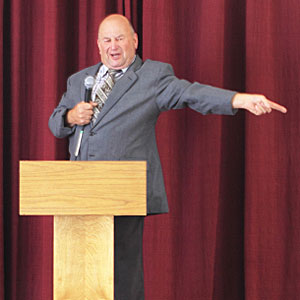The aim of any presenter is to be trusted. Yet, time after time, listeners aren’t sold. Many even comment, “You know, there is something about that guy that I just can’t trust.” What you say and how you say it is critical to establishing trust. Albert Mehrabian, Professor Emeritus at UCLA, identified that tone of voice and body language conveys the speaker’s feelings and attitudes towards his/her words. If there is any incongruence, people will trust the visual 55% of the time, the tone of voice 38% of the time and the words only 7% of the time. It is important for you to be aware of what you might be doing to erode trust and avoid dangerous pitfalls.
Verbal Message
With regards to your actual words, always assess whether your message is logical. Does Point A lead to Point B, etc? Have you buried your ideas in too much verbiage? Do you over-talk an issue or get lost in too much detail? Would listeners feel you have supported your argument with suitable data, trends or financial analyses or are there missing pieces? Would the action you are requesting seem appropriate based on what you have said? A speaker who wants to be trusted must have a strong message and offer solid advice. The more complex the message, the more in danger you are of straying off the path. A confused mind never gives a nod of approval.
Vocal Message
A voice that is marred with non-words- ums and ahs, is not the mark of a credible speaker. Neither is a monotone. Listeners need to hear your enthusiasm or sincerity. Your voice must have vocal variety. If it doesn’t, you are eroding your impact. People will wonder why they should believe you.
Visual Message
A lot of speakers feel the only thing they need to consider is their message, but body language, things like eye contact, gestures, facial expression, and posture definitely affect trust. Listeners immediately notice whether you are looking them in the eye. If your eyes are scanning the room, if you are reading from your notes or the screen, the subliminal message is that you are unsure, maybe not convinced. People feel that if you believed in what you were saying, you would look them in the eye.
An audience also pays attention to what you are doing with your hands. Are you fidgeting with rings or pens? Are you making fists instead of using an open hand? Do you seem closed with your arms locked across your chest? Are your hands hidden in your pockets or locked behind your back? Are you pointing or standing with your hands clasped on your hips. To trust you, listeners need to feel you have nothing to hide, that you are open and receptive to their thinking or viewpoints when you stand before them.
People often rely on your face to provide clues on how they should react or for information that supports or contradicts your verbal messages. A face lacking expression is deadly – so is one that shows fear or annoyance. A meeting, whether with the boss, an internal team or a customer, is not the time for a poker face. Your face should reflect the enthusiasm or concern you feel for your topic. If your facial expression does not match your words, you risk not being seen as trustworthy and credible.
Lastly, posture plays into whether you are trusted. Mothers always say stand up straight or sit up straight. They harp on posture because they want others to conclude you are confident. If there is anything about your posture that says you aren’t sure, you must be diligent about avoiding it. This includes rocking or swaying.
Trust can be derailed or encouraged if the message is incongruent. It is up to you to ensure that your body and voice back up your words.
Question: When you give a presentation, what is challenging for you? What worries you the most? We’re interested in your reaction to this article.
To add your comments click in the “Comment” box below and begin writing. Any questions will be answered by Judy.
Impact Communications, Inc. consults with individuals and businesses to improve their presentation and telephone communication skills. It is not what you know but how you communicate it that makes a difference. When you have to have impact, phone (847) 438-4480 or visit our website, www.ImpactCommunicationsInc.com.

Impact Communications, Inc. was established in 1998. It is a national presentation communication skills and telephone communication skills training company that excels at defining and developing the core elements of effective business communication. With presentation communication skills training, telephone communications skills training, every encounter can be an efficient and lucid transmission of information.






Recent Post Comments